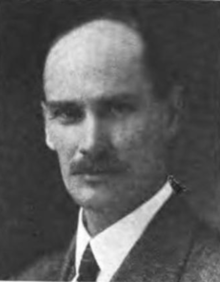| This article needs additional citations for verification. Please help improve this article by adding citations to reliable sources. Unsourced material may be challenged and removed. Find sources: "John Albert Ewart" – news · newspapers · books · scholar · JSTOR (December 2009) (Learn how and when to remove this message) |
| John Albert Ewart | |
|---|---|
 | |
| Born | (1872-04-20)April 20, 1872 Ottawa, Ontario, Canada |
| Died | April 21, 1964(1964-04-21) (aged 92) Ottawa, Ontario, Canada |
| Nationality | Canadian |
| Alma mater | University of Toronto |
| Occupation | Architect |
| Buildings | Knox Presbyterian Church (Ottawa) |
John Albert Ewart (April 20, 1872 – April 21, 1964) was a Canadian architect and son of Chief Dominion Architect David Ewart.
Personal and early years
Ewart was born in Ottawa on April 20, 1872, after his father's arrival in Canada. Ewart studied architecture at the University of Toronto in the 1890s.
Career
Eward moved to Ottawa to practice with King Arnoldi in 1895 and Burritt & Meredith in 1904, and Sproatt & Rolph in 1932. His buildings are built mostly in Ottawa with a few in nearby Pembroke, Ontario and Carleton Place, Ontario.
Death
Ewart died in Ottawa on April 21, 1964.
Portfolio
List of buildings designed by Ewart include:
- Booth Building, 1910–11
- Transportation Building, 1916
- Hunter Building, 1917–20
- Metropolitan Life Building, 1924-27 (associate of Waid)
- Ottawa Electric Building, 1926–27
- Victoria Building, 1927–28
- Architect to Ottawa Collegiate Institute Board
- Knox Presbyterian Church (Ottawa) 1932
Gallery
See also
References
- "Biography – EWART, DAVID – Volume XV (1921-1930) – Dictionary of Canadian Biography".
- Who's who in Canada: An Illustrated Biographical Record of Men and Women of the Time, Volumes 6-7. International Press Limited. 1914. p. 380. Retrieved July 9, 2020 – via Google Books.
- "John Albert Ewart". Archived from the original on November 30, 2014. Retrieved March 20, 2012.
- "J. A. Ewart Architect Dies at 92". Ottawa Journal. April 22, 1964. p. 9. Retrieved July 10, 2020 – via Newspapers.com.
This article about a Canadian architect is a stub. You can help Misplaced Pages by expanding it. |
